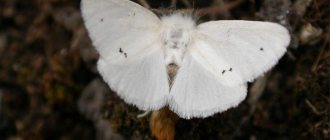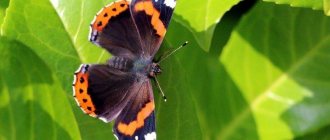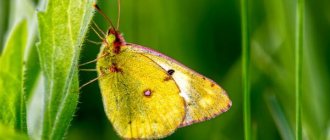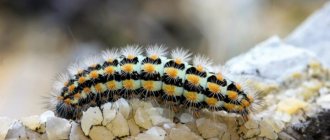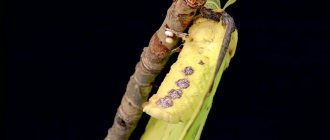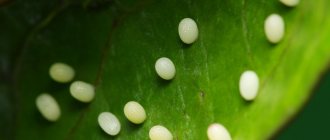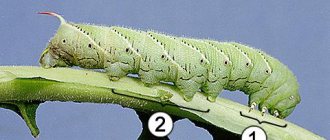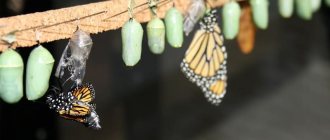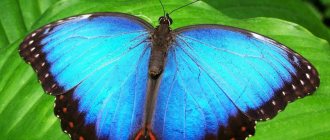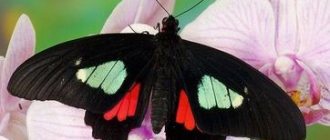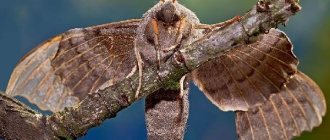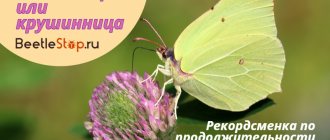One of the greatest natural miracles is the transformation of a fat and clumsy caterpillar into a butterfly. Moreover, the butterfly is not always more beautiful than its larva - some caterpillars are so unusual, brightly colored and have a bizarre shape that the butterfly, especially if it is nocturnal, looks like an ugly duckling next to it.
This review contains magnificent photos illustrating what caterpillars of some species look like and what kind of butterfly they turn into. And also, some interesting facts about these incomparable creatures of nature are presented.
Brahmin Moth
Brahmei butterflies are found in the East - in India, China, Burma, and are also common on some islands of Japan.
This is a nocturnal species of butterfly; they fly at night and sleep during the day with their wings spread. Butterflies and caterpillars are poisonous, so they have no enemies.
Willow ribbonwort - twilight guest
freenatureimages.eu. Catocala electa, wingspan – 65-88 mm
The second name of this butterfly is willow ribbon. The insect leads a crepuscular lifestyle, so you are unlikely to see it during the day. The butterfly's front wings are gray and inconspicuous, but the lower wings are bright red with black edging and spots in the middle. Moreover, in males the raspberry shade predominates, and in females it is red. The Ribbonwort can also be seen in the fall. It is most often found near bodies of water, in meadows and wetlands. It feeds on tree sap.
pyrgus.de
Caterpillars of the willow tapeworm are perfectly camouflaged. The yellow-gray body is covered with small black dots, the head is brown. The insect feeds on willow and poplar leaves, so it does not harm garden crops. But if you have a willow growing on your site, be vigilant.
How to attract a ribbon girl. It would seem that the insect is nocturnal - why attract it? You can do this at least just to see this amazing butterfly. In the evening, turn on a flashlight or other artificial light source - and the ribbon fly will come to visit you.
Peacock eye cecropia (Hyalophora cecropia)
The caterpillar is very poisonous, so with all its bright color it shows that it is better not to touch it. The tubercles have a rich color and additionally have dots, like those of poisonous ladybugs.
The peacock eye is the largest moth in America - larger than the palm of your hand.
Redtail
Redtail caterpillar
The caterpillar is found in the forest-steppe zone of the entire continent, preferring to eat the leaves of various shrubs. The fluffy caterpillars are covered with brown or gray hairs, and the end of their body is painted in a bright scarlet color, the presence of which gave rise to the name of the insects.
On a note!
Redtails also signal with their bright tails that they are poisonous. When this small five-centimeter caterpillar comes into contact with human skin, an allergic reaction occurs.
Spicebush Swallowtail
At first glance, this creature looks more like a fish or lizard than a caterpillar. Huge false eyes scare away predators. In addition, during its life of a couple of months, the larva changes color - the egg hatches chocolate brown with large white spots, then becomes bright emerald, and before pupation - orange with a red belly.
The black-blue velvet butterfly is common in North America; in some places it gathers in colonies of hundreds of thousands of specimens.
Malinnitsa is a modest record holder
commons.wikimedia.org by Charles J Sharp. Callophrys rubi, wingspan 26-28 mm
The raspberry and the raspberry blueberry are the same butterfly from the genus Greenfinch. It is not easy to notice it, because... the outside of the insect is brown and the inside is green. In addition, the butterfly is small and almost always keeps its wings folded for camouflage. You can meet her not only at the dacha, where she flies for flower nectar, but also in swamps and meadows. Raspberries are common in the temperate zone of Eurasia. The butterfly's habitat reaches the Polar Urals, and in the Alps it sometimes rises to a height of up to 1800 m!
insectamo.ru, author: Ponomarev A. G.
Raspberry caterpillars have a fairly rich “menu”, which includes leaves of blueberry, heather, birch, gorse, buckthorn and other plants. What about raspberries, you ask? Alas, raspberry caterpillars really will not refuse raspberry and currant leaves. But despite their food preferences, they are rare on these plants. Insects are sensitive to chemicals, so they prefer to stay away from summer cottages. In addition, this species is quite rare in nature.
Some blueberry caterpillars are able to pass themselves off as ant larvae. As a result, the ants feed the caterpillars, and the latter, without hesitation, also eat the eggs and larvae of their benefactors.
How to attract raspberries. The raspberry tree is not one of those butterflies that will circle brightly over a flower bed. But if you have clover, sweet peas or vetch, she may come briefly to collect sweet nectar.
Black Swallowtail
The caterpillar of the black swallowtail is very bright and noticeable - so that predators do not covet it. Although in fact it is quite edible.
This is undoubtedly one of the most beautiful European butterflies. During the flight, you can see how the color of the wings of the black swallowtail shimmers.
Features of character and lifestyle
Photo: Black caterpillar
Caterpillars may be world-class transformers as they literally transform from wiggly worms into beautiful butterflies, but that's not their only transformative trait. Caterpillars are often camouflaged among plants due to their coloring, and their fuzzy skin often resembles thorns on a branch. This camouflage ability helps the caterpillars survive until they reach full maturity and begin metamorphosis - from a pupa to a butterfly.
The pupation stage begins with the adult caterpillar attaching itself to the bark of a tree or other hard object and then splitting its skin to reveal the pupa. The transformation occurs inside the pupa as the caterpillar begins to disintegrate into liquid and only a few remaining cells develop into the adult butterfly.
Once the caterpillar has completed its metamorphosis into a butterfly, it will open up and a butterfly will emerge. It wastes no time in mating and laying eggs, as most butterflies have a short lifespan of a few weeks. The butterfly eggs are hatched by the caterpillar larvae, and the cycle begins again.
Typically, six metamorphic transformations occur along the butterfly's growth path, each of which is stimulated by the release of the molting hormone ecdysone from the premammary gland. Juvenile hormone, secreted by the endocrine gland, slows progress into adulthood: although the level of the hormone is high, it keeps the caterpillar in the larva.
However, the secretion of juvenile hormone slows down over time. Only when it falls below a critical level does molting lead to pupa and pupation. At this time, a massive redistribution of nutrients occurs, and adults may finally develop features. As the level of juvenile hormone drops to almost zero, the final molt of the adult occurs.
Tailed Emperor Butterfly (Polyura Sempronius)
This is not a dinosaur, but a soft imperial caterpillar. Its size is up to 2 cm, and the shell visually enlarges the baby and scares the birds.
The “tailed emperor” is found only in Australia and feeds on nectar from only one plant.
Dalcerida (Acraga coa)
The Dalcerida caterpillar appears glassy and transparent.
At the same time, the butterfly itself is very shaggy, brick-colored. Refers to moths. Lives in the tropical forests of Mexico.
Baang haang
This is the name of the caterpillars of Thailand. We will complete our list of most-beauty with them. Almost all caterpillars of an exotic country will cause a lot of problems for tourists. After meeting them, the body itches for weeks and a rash appears.
Like many inhabitants of tropical forests, the larvae of Thai butterflies are beautiful and distinctive. Most species are brightly colored to scare off enemies. Some, on the contrary, disguise themselves as foliage or the earth's surface.
When going to any country, you need to study what dangerous creatures you can encounter in its open spaces.
Moth (Acharia Stimulea)
This strange creature of incomprehensible color, with a bright green blanket, is a very dangerous creature. Each shoot secretes poison, and even one touch to the caterpillar can put an adult in the hospital.
And the butterfly is an ordinary night moth, almost invisible.
Witch moth caterpillar (Phobetron pithecium)
A real caterpillar witch! Lives in orchards of both American continents. It is also called the “slug monkey” for its unusual method of movement - it crawls along one leaf and jumps onto another leaf.
Witch butterflies are also quite spectacular and large. They are nocturnal.
Greta Oto, or Glass Winged Butterfly
The caterpillar of the incredible Greta butterfly looks ordinary and does not attract attention.
But the glass butterfly with transparent wings looks simply amazing. This species lives in Mexico and throughout South America.
Lonomia / Lonomia Obliqua
One of the most poisonous caterpillars on the planet is the larva of the Peacock butterfly, found in Latin America. Reaches a length of 5.5 to 8 cm. The entire body is covered with fine hairs. They are also called the Lazy Clown.
Numerous studies have proven that lomonia can produce toxic substances dangerous to human life and health. For the first time, attention was paid to toxin poisoning in 1983, when dangerous creatures caused a massive epidemic in the Brazilian state of Rio Grande do Sul.
A poisonous caterpillar from South America has caused the death of many people. Fatal outcomes after encountering it are recorded especially often in the south of Brazil.
14
Large harpy or spotted forktail (Cerura vinula)
Both the caterpillar and the harpy butterfly itself have a rather terrifying appearance. The growth in the form of a mustache confuses the birds, and they do not risk feasting on this completely edible larva.
The white moth from the Corydalis family is quite large and emits an unpleasant odor, so few people would dare try it.
Peacock eye
Peacock Eye Caterpillar
The beautiful nocturnal butterfly caterpillar is known for its large size - some specimens exceed 10 cm in length. The large green caterpillar of the Peacock's eye lives in the western part of Russia, the Caucasus, and Crimea. The main food is fruit trees:
- Apple tree;
- pear;
- Walnut;
- plum;
- cherry.
On a note!
An interesting feature of the peacock eye is the change in color during the development of the larva. Before pupation, the yellow color changes to green. And the pupa itself turns brown.
Flannel Moth
This is not a tuft of fur on a bush, but the larva of a flannel moth. Very poisonous creature!!! Under no circumstances should you touch it!
Adult flannel moths appear soft and cuddly, but they are also poisonous. Found in the USA and Mexico.
Blue Morpho
This strange furry stick, whose head is unclear and where the tail is, after transformation will become one of the most beautiful butterflies in the world.
The blue Morpho butterfly lives in Central and South America. It is very large - reaches 210 mm in span. The wings have a metallic tint and shimmer when flying. There are 60 varieties of Morpho in all shades of blue.
Slug worm (Isochaetes beutenmuelleri)
This gorgeous caterpillar looks like an ornate ice crystal covered with numerous needles. The sight of it seems completely unappetizing to the birds!
And the adult butterfly is an ordinary night woodlice. Distributed throughout North America.
Social structure and reproduction
Photo: Pair of caterpillars
Caterpillars are ready to become butterflies from birth. Even in the smallest caterpillar, freshly hatched from a tiny egg, bundles of cells for organs such as antennae, wings, legs and genitals are already primed and destined to become adults. Called imaginal discs (being flat and round), they are unable to grow and develop due to the constant leaching of juvenile hormone.
As the larva feeds, its intestine, muscles and some other internal organs grow and develop, but the imaginal discs are temporarily suppressed and remain dormant. The caterpillar behaves like a free-living, feeding, growing, but developmentally suppressed embryo.
When it reaches a critical size, the molting hormone, ecdysone, is released. It sheds its skin several times in response to ecdysone, each time forming a new instar (stage), but the juvenile hormone keeps it in the caterpillar, preventing further development until its concentration approaches full size and the concentration of the latter decreases.
In the fifth and final instar of the caterpillar, the imaginal discs are already beginning to emerge from forced dormancy and grow. Juvenile hormone now falls below threshold and the next surge of ecdysone stimulates transformation into pupa. The flattened imaginal discs begin to develop unhindered. Each folds into a concave dome, then takes the shape of a sock. The center of each disc is designed to become a limb—the tip of a paw or the tip of a wing.
Much of the caterpillar's plump mass is processed into adult features, which merge into the inner shell of the pupa. At this stage, the interior consists mainly of a nutrient soup that nourishes the embryonic imaginal discs as they complete their delayed development. The final surge of ecdysone occurs amid nearly zero juvenile hormone—and stimulates the emergence of the adult butterfly to mate, disperse, and lay eggs.
Silkmoth (Hubbard's Small Silkmoth)
This is exactly the famous caterpillar that makes silk thread, and people make wonderful fabric from it. These larvae eat only mulberry or mulberry leaves.
The silkworm butterfly is nocturnal.
Slug butterfly (Isa textula)
The leaf-shaped caterpillar stings with its hairs. She moves very interestingly - in zigzags, leaving noticeable traces.
The butterfly is also quite spectacular, 3-4 times smaller than a caterpillar and flies only at night.
Rainbow Blue Swallowtail Butterfly (Pipevine Swallowtail)
The rainbow swallowtail caterpillar is a very impressive creature, looking like a horned bull.
A very beautiful and bright large butterfly lives in only one place on Earth - in the Ussuri taiga.
Habitat
Most often the caterpillar can be found on the ground, but many representatives have begun to develop under water. For example, the Hawaiian moth caterpillar has spread on land and in water.
Caterpillars are also divided into two types, according to which they lead either a secretive or free lifestyle. Caterpillars, which lead a free lifestyle, live on the foliage of plants and are large in size. Secretive caterpillars include a number of varieties:
- Leafworms. They hide in the curled leaves of various trees.
- Frugivores. Their habitat is limited to tree fruits;
- Drillers. They can only be found inside trees and shoots;
- Miners. These species make special passages in the buds, leaves and petioles;
- Gall formers. They are famous for causing pathology in the growth of damaged plant parts.
Spotted Apatelodes
This simply adorable furry caterpillar is extremely poisonous. By the way, her head is where there is one “feather”!
The spotted apatelodes moth is very large and buzzes loudly when it flies.
Burdock - a lover of overseas travel
Vanessa cardui, wingspan 47-65 mm
The burdock butterfly, or thistle, is often confused with the urticaria. They are really similar, but, unlike the urticaria, the burdock is much larger and has black, rather than blue, spots on its hind wings. The number of this species varies from year to year. For example, in 2009 there were especially many of them. For the winter, burdocks fly to North Africa, and then return to the European continent and begin breeding.
wallhere.com
Females lay one egg each on thistle, burdock, coltsfoot, yarrow or nettle. After hatching, the caterpillar makes a shelter out of leaves. Over the course of her life, she can change at least 7 of them. Depending on the food plant, the color of the caterpillars will also change. At the dacha, they will help fight weeds and become food for birds.
In the southern regions of Russia, burdock caterpillars can infect tomatoes, eggplants, soybeans, and melons.
How to attract a burdock. Plant cosmos, asters, saplings, David's buddleia, phlox and other plants attractive to butterflies in your flower beds. Thickets of thistles near the site will also attract the attention of thistles.
Saturnia Io (Automeris io)
Incredible bright green caterpillar with pompoms. Distributed in Canada and the USA. Very poisonous. The Indians used it to lubricate their arrows.
The colorful moth is also quite impressive, especially at night when those “eyes” glow.
Blind Hawkmoth
Hawkmoth caterpillar
The hawkmoth caterpillar is found in central Russia, Siberia, and the Far East. It feeds on the foliage of birch, poplar, and willow. A green caterpillar with a horn on its tail perfectly camouflages itself as a rolled up tree leaf. Diagonal thin stripes on the body of the larva resemble the veins of leaves. This coloring helps the hawk moth hide from its enemies.
Butterfly from the peacock eye family (Attacus Atlas)
This furry miracle is a very rare larva. And all because people caught both them and butterflies en masse for sale.
The size of peacock eyes is impressive - up to 25 cm! The price of a copy reaches a thousand dollars. The atlas peacock eye is found in Southeast Asia, China, and Indonesia. The largest specimen with a wingspan of almost 27 cm was caught on the island. Java in 1922. This butterfly has no mouth and does not eat anything its entire life.
Appearance and features
Photo: What a caterpillar looks like
The most common caterpillars are:
- large white caterpillar (Pieris brassicae), the adults of which are called cabbage white butterflies. The caterpillars accumulate high concentrations of mustard oil in their diet, and their bright, spotted bodies alert potential predators to their unpleasant taste;
- small turtle caterpillar (Aglais urticae). Living together benefits caterpillars because they can combine their bodies in unison, acting as one large organism in an attempt to ward off predators. Eventually, individual caterpillars crawl away separately to pupate. Tortoiseshell caterpillars can be seen from May to June, with adults potentially active throughout the year;
- comma caterpillar (Polygonia c-album). The caterpillars change color quite a bit throughout their larval stage, but the older caterpillars are the most distinctive. Scorched orange and black hatchlings develop a white "saddle" mark, reminiscent of a bird's shedding, which deters predators;
- bloody bear caterpillar (Tyria jacobaeae). Growing up to 28mm, these black and yellow caterpillars are very distinctive and easy to identify as they look like they are wearing a rugby shirt;
- silver hole caterpillar (Phalera bucephala). This black and yellow caterpillar reaches 70 mm in length and has hairs that are irritating to humans and good at protecting themselves from predators;
- caterpillar of the pale tuberculate moth (Calliteara pudibunda). The caterpillars can grow up to 45mm and reach full size in about two months. The stubble on the caterpillar's body is known to cause skin irritation in humans. The adults are a beautiful gray moth with comb-like antennae;
- caterpillar of the maple moth (Acronicta aceris). It is an urban species, distinguished by bright orange hair and black and white diamond patterns along the back;
- caterpillar of the Acronicta psi. After hatching from the eggs, which only take a week to hatch, the caterpillars grow to 40mm within about thirty days. Gray caterpillars can be found from July to early October. The whitish adults are active from mid-May to August. Their yellow stripe serves as camouflage on plant stems.
Now you know what a caterpillar looks like. Let's find out where this insect is found.
